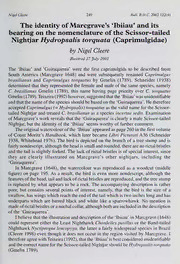
The Identity of Marcgrave's 'ibiiau' and Its Bearing on the Nomenclature of the Scissor tailed Nightjar Hydropsalis Torquata (Caprimulgidae) PDF
Preview The Identity of Marcgrave's 'ibiiau' and Its Bearing on the Nomenclature of the Scissor tailed Nightjar Hydropsalis Torquata (Caprimulgidae)
NigelCleere 249 Bull. B.O.C. 2002 122(4) The identity ofMarcgrave's 'Ibiiau' and its bearing on the nomenclature ofthe Scissor-tailed Nightjar Hydropsalis torquata (Caprimulgidae) by Nigel Cleere Received27July 2001 The Tbiiau' and 'Guiraquerea' were the first caprimulgids to be described from South America (Marcgrave 1648) and were subsequently renamed Caprimulgus brasilianus and Caprimulgus torquatus by Gmelin (1789). Schneider (1938) determined that they represented the female and male ofthe same species, namely C. brasilianus Gmelin (1789), this name having page priority over C. torquatus Gmelin(1789). Teixeira(1992)however,suggestedthatthe Tbiiau'wasunidentifiable andthatthenameofthe species shouldbebasedonthe 'Guiraquerea'. Hetherefore accepted Caprimulgus (= Hydropsalis) torquatus as the valid name forthe Scissor- tailed Nightjar and treated C. brasilianus as a species incertae sedis. Examination ofMarcgrave's work reveals that the 'Guiraquerea' is clearly a male Scissor-tailed Nightjar, but the identity ofthe Tbiiau' seems worthy offurther comment. Theoriginal watercolourofthe Tbiiau' appearedaspage260inthefirstvolume of Count Moritz's Handbook, which later became Libri Picturati A36 (Schneider 1938, Whitehead 1976). The bird is depicted on the branch of a tree stump and is fairlynondescript, althoughtheheadissmallandrounded,therearenorictalbristles and the tail is slightly forked. The lack ofrictal bristles is ofspecial interest, since they are clearly illustrated on Marcgrave's other nightjars, including the 'Guiraquerea'. In Marcgrave (1648), the watercolour was reproduced as a woodcut (middle figure) on page 195. As a result, the bird is even more nondescript, although the featuresofthehead,tailandlackofrictalbristlesarereproduced, andthetree stump is replaced by what appears to be a rock. The accompanying description is rather poor, but contains several points of interest, namely, that the bird is the size of a swallow, has wings whichreach theendofthetail whichistwo inches long andhas underparts which are barred black and white like a sparrowhawk. No mention is madeofrictalbristlesoranuchalcollar, althoughbothareincludedinthedescription ofthe 'Guiraquerea'. Ibelieve thatthe illustration anddescriptionofthe Tbiiau' in Marcgrave (1648) could represent either the Least Nighthawk Chordeilespusillus or the Band-tailed NighthawkNyctiprogne leucopyga, the latter a fairly widespread species in Brazil (Cleere 1998) even though it does not occur in the region visited by Marcgrave. I thereforeagreewithTeixeira(1992),thatthe Tbiiau'isbestconsideredunidentifiable andthecorrect nameforthe Scissor-tailedNightjarshould be Hydropsalis torquata (Gmelin 1789). NigelCleere 250 Bull. B.O.C. 2002 122(4) Acknowledgements I wishto thankEffieWarratthe Natural History Museum,Tring andLindaBirch at the Alexander Library, Edward Grey Institute, Oxford, for their kind assistance in helping me to track down the relevant literature. I would also like to thank David Christie for all his help in preparing this note and Jose Fernando Pacheco for commenting on an earlierdraft. References Cleere, N. 1998.Nightjars.Aguidetonightjarsandrelatednightbirds. PicaPress, Sussex. Gmelin,J.F. 1789. SystemaNaturae 13thEd.Vol 1,Pt. 2. GE.Beer,Liepzig. Marcgrave, G. 1648. In Piso, G. & Marcgrave, G. Historia Naturalis Brasiliae. Lugdun Batavorum, Amsterdam. SchneiderA. 1938.DievogelbilderzurHistoriaNaturalisBrasiliaedesGeorgMarcgrave.J. Orn.86(1) :74- 106. Teixeira,D.M. 1992.Asfontesdoparaiso-UmensaiosobreaOrnitologianoBrasilHolandes(1624- 1654).Rev. Nord. Biol. 7 (1/2) : 1 - 149. Whitehead,P.J.P. 1976.TheoriginaldrawingsfortheHistorianaturalisBrasiliaeofPisoandMarcgrave (1648)./. Soc. Biblphy. Nat. Hist.7 (4) : 409-422. Address 2HawthornHouse,Roundfields,UpperBucklebury, Berks. RG76RQ,U.K. : ©BritishOrnithologists' Club2002 Species limits in the Brown Boobook Ninox scutulata complex by Ben King Received 13June 2001, revision received21 October2002 Most ofthe currently recognized subspecies ofBrown Boobook or Brown Hawk- owl Ninox scutulata were originally described as separate species, but subsequent authors have followed Peters (1940) in maintaining them as members of a single species. Indeed, mostofthesetaxaarequite similarmorphologically. However, like Oba(1988),butcontra Konigetal. (1999), Ifoundthattheterritorial songsofsome ofthe races differ so markedly as to call their conspecificity into question. Given that voice is the primary means of communication for nocturnal birds, selective pressure for intraspecific retention of stereotyped songs is likely to be strong, and nocturnalbirdswithdifferentsongsarethereforelikelytorepresentdifferentspecies. Theaimofthispaperistoexaminethetaxonomyofthisgroupofowlsinrelation to the form oftheir songs. Tape recordings were obtained ofthe territorial songs of each ofthe 11 subspecies ofNinoxscutulatarecognisedby Konigetal. (1999). The sources ofthese recordings are given in the Acknowledgements. Sonograms were made using Canary 12.4, the Cornell Bioacustics Workstation of the Bioacustics Research Program at the Cornell Laboratory ofOrnithology.
